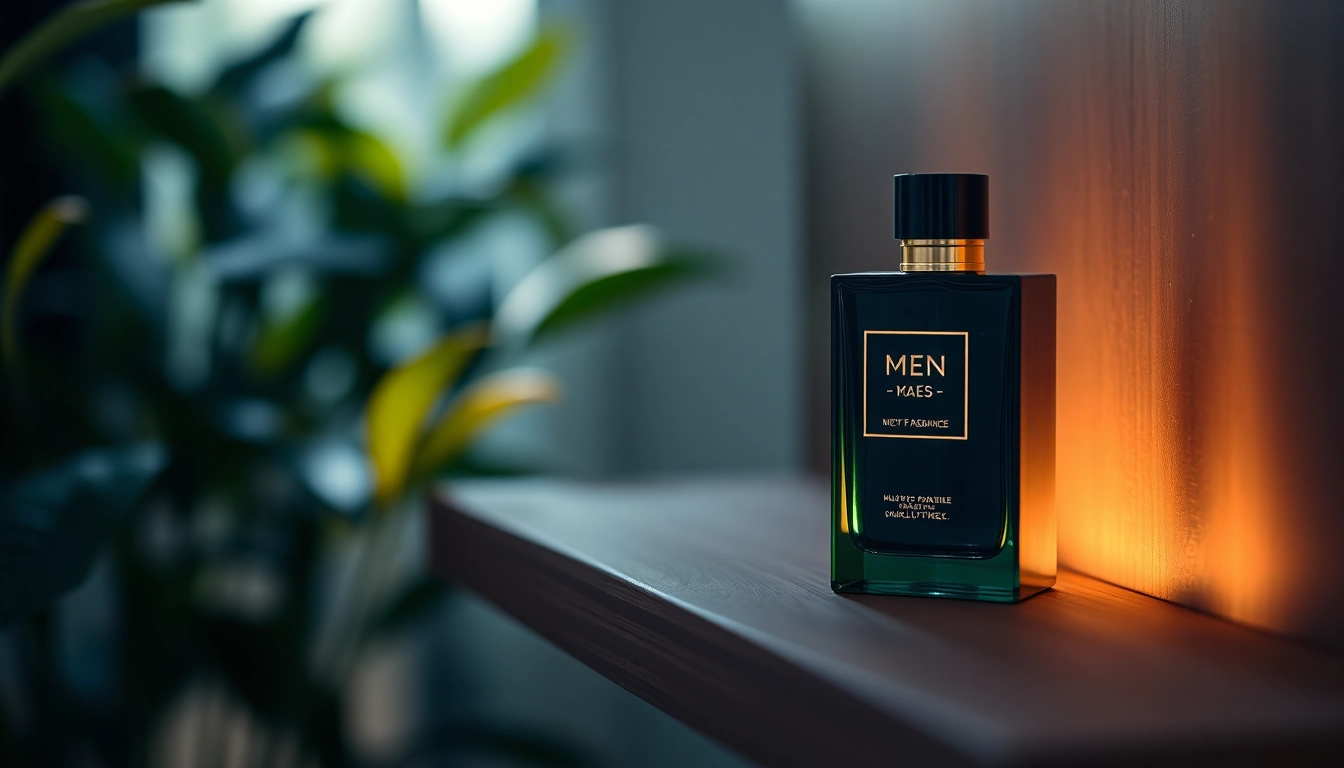Understanding Men’s Fragrance Basics
The world of men’s fragrance is rich and diverse, comprising an array of scents that can enhance one’s personality and style. Understanding the basics of fragrance is crucial for anyone looking to find their signature scent. This section will delve into what makes a great fragrance, explore various fragrance families, and help you choose the right scent that resonates with your identity.
What Makes a Great Fragrance?
A great fragrance is more than just a pleasant aroma; it embodies emotions, memories, and personal expression. The components of a great fragrance often include:
- Top Notes: The initial scents that are perceived immediately upon application, these are often light and fresh. Common top notes include citrus, mint, and aromatic herbs.
- Middle Notes: Also known as heart notes, they emerge after the top notes fade. These scents are typically floral, fruity, or spicy, providing depth to the fragrance.
- Base Notes: The foundation of the fragrance, these deep and rich notes linger the longest, with common ingredients like vanilla, musk, and various woods.
- Longevity and Sillage: A great fragrance not only lasts longer but also leaves a pleasant scent trail, known as sillage. High-quality fragrances achieve both.
The balance between these elements defines a great fragrance, with harmony resulting in a scent that feels uplifting and sophisticated.
Fragrance Families Explained
Fragrances are categorized into several families, each defining a particular scent profile. Understanding these families can help you navigate the myriad of options available:
- Citrus: Fresh, zesty scents from fruits like lemon and grapefruit. Ideal for a youthful, vibrant aura.
- Woody: Earthy tones derived from trees and plants, perfect for a grounded, masculine feel.
- Spicy: Bold and exotic, incorporating elements like pepper and cinnamon, these scents provide warmth and complexity.
- Floral: Not just for women, floral notes can add an elegant touch to men’s fragrances, usually balanced with deeper notes.
- Oriental: Rich, luxurious scents featuring ingredients like amber, musk, and resin, perfect for evening wear.
Experimenting with different fragrance families can lead you to unexpected preferences, enhancing your overall scent wardrobe.
Choosing the Right Scent for You
Choosing a fragrance is a highly personal decision influenced by individual taste, occasion, and even body chemistry. Here are essential tips for selecting the right scent:
- Know Your Chemistry: Fragrances react differently with skin types due to pH, hydration levels, and individual body heat.
- Consider Your Lifestyle: Choose scents that align with your daily activities and lifestyle. A fresh, clean scent may be more suitable for office settings, while richer, deeper notes might be ideal for evenings out.
- Test Before You Decide: Always test fragrances on your skin. Allow them to develop over a few hours before making a decision. Fragrance can change significantly once it interacts with your body’s chemistry.
- Seek Feedback: Sometimes, the perception of a fragrance by others can differ from your own. Trust friends or family to provide input on how a fragrance suits you.
Popular Men’s Fragrance Trends
Keeping up with current trends can significantly enhance your fragrance collection. In recent years, certain trends have gained prominence, reflecting changing consumer preferences and the evolving fragrance landscape.
The Rise of Natural Ingredients
A notable trend is the increasing demand for natural and sustainably sourced ingredients. Consumers are becoming more aware of environmental impact and seek fragrances made from natural components such as essential oils and botanical extracts. These scents not only provide a more authentic aroma but often are free from synthetic chemicals that might cause irritation. Brands focusing on eco-friendly practices often attract a loyal customer base that values transparency and sustainability.
Signature Scents for Men
The concept of a signature scent—an aromatic representation of one’s personality—is gaining traction among men. A signature fragrance can make an unforgettable impression and even evoke specific memories or associations. Men today are encouraged to choose scents that resonate with their style, rather than simply following trends. A signature scent often becomes a key part of a man’s identity; finding one that speaks volumes about who you are is paramount.
The Influence of Celebrity Fragrances
Celebrity fragrances have stunned the fragrance industry, as renowned personalities lend their names and lifestyles to scents. These fragrances often promise a glimpse into the celebrity’s persona. While some may argue against their authenticity, the allure of a celebrity’s lifestyle can be enticing to many consumers.
Moreover, collaborations between established fragrance houses and celebrities often lead to innovative and appealing scents, captivating a diverse audience searching for that celebrity touch in their daily lives.
How to Apply and Layer Fragrance Effectively
Once you’ve selected the perfect scent, knowing how to apply and layer fragrances can enhance your overall experience and longevity. Proper application and clever layering techniques can elevate your fragrance game.
Application Techniques
The application of fragrance is an art form, often overlooked. Here are some effective techniques:
- Pulse Points: Apply fragrance to pulse points where the skin is warmer, such as wrists, behind ears, and neck. This helps the scent develop and linger longer.
- Spraying vs. Dabbing: Spraying creates a fine mist that envelops you, while dabbing is more concentrated and is ideal for rich, heavy scents.
- Distance Matters: Maintain about six inches between your skin and the fragrance atomizer to avoid overwhelming any one area.
- Avoid Rubbing: After applying, resist the temptation to rub your wrists together; this can alter the composition of the fragrance.
Creating a Layered Fragrance Experience
Layering scents can create a unique and personal fragrance profile. Here are some tips for effective layering:
- Use Complementary Scents: Layer fragrances from the same family or fragrances that share common notes for a more cohesive result.
- Start with a Base: Begin with a neutral base fragrance and add scents to enhance your unique profile. A lightly scented moisturizer can help anchor your fragrance.
- Experiment with Concentrations: Use different concentrations (Eau de Toilette layered with a solid perfume) to create depth.
However, be mindful not to overdo it; a little goes a long way.
Common Application Mistakes to Avoid
Even fragrance enthusiasts might make common mistakes. Here are some pitfalls to watch out for:
- Over-application: Too much fragrance can be overpowering and off-putting. Less is often more.
- Ignoring Occasion: Some fragrances are more suitable for certain occasions than others. Choosing the wrong scent can be distracting.
- Storing Improperly: Exposure to light and heat can degrade the fragrance quality. Store your fragrances in a cool, dark place.
Fragrance for Different Occasions
Fragrances can significantly influence the mood and impact of any occasion. Understanding which scent to wear in various scenarios can enhance the experience for both the wearer and those around them.
Everyday Scents for Work
For the office, opt for scents that are subtle yet present, fostering an inviting work environment without overpowering your colleagues. Fresh and clean notes tend to work best:
- Citrus: Invigorating and uplifting, citrus notes can stimulate the mind and maintain a positive atmosphere.
- Aquatic: Light and refreshing, aquatic fragrances are a cool option, perfect for dynamic office settings.
- Green Notes: Scents that embody grass, leaves, or herbs lend a natural vibe, ideal for informal work settings.
Evening & Event Fragrances
Evening fragrances are usually richer and more sensual. Opt for deeper, bolder scents that evoke a sense of elegance and sophistication:
- Oriental Scents: These fragrances often blend spices, resins, and warm notes that are inviting yet captivating.
- Woody Fragrances: Scents such as sandalwood and cedar create a strong, enduring impression appropriate for formal events.
Evening fragrances allow for more complexity, providing an opportunity to express individuality.
Seasonal Fragrance Choices
Understanding how to adjust your fragrance wardrobe with the changing seasons can enhance your olfactory experience:
- Spring: Fresh and floral scents with green notes, embodying the vibrancy and renewal of the season.
- Summer: Light, citrusy aromas, or aquatic fragrances to stay cool during warmer months.
- Autumn: Warm, woody, and spicy notes that evoke the coziness of falling leaves and cooler breezes.
- Winter: Rich, deep scents are ideal, with hints of warmth and nostalgia often found in oriental and gourmand fragrances.
Maintaining Your Collection
Owning a variety of fragrances requires proper care to ensure their longevity and quality. Here are essential tips for maintaining your fragrance collection:
Storing Fragrances Properly
Storage is essential in preserving the integrity of your fragrances. Consider these practices:
- Avoid Sunlight: Always store fragrances in a dark place to prevent degradation from UV rays.
- Cool Temperatures: Keep your fragrance in a cool, stable environment to prevent any chemical changes.
- Avoid Humidity: Areas of high humidity, like bathrooms, can deteriorate the fragrance process, so it’s best to store them in a more controlled environment.
Refreshing Older Fragrances
Sometimes, fragrances can lose potency over time if not stored correctly. Refreshing your collection can rejuvenate older scents:
- Test for Changes: If a fragrance smells off or has changed color, it may be time to part ways.
- Layering: Layer older fragrances with newer scents can also create new profiles if they retain their aromatic properties.
When to Replace Your Fragrance
Beyond physical changes, knowing when to replace fragrances is equally crucial. Generally, a good fragrance should last three to five years, but certain signs can indicate it’s time for a change:
- Off-Putting Odors: If the fragrance smells sour or unpleasant, it might be best to discard it.
- Color Changes: A significant change in color can suggest breakdown in the formulation.
Building a prized fragrance collection can be a wonderful journey through scent. With knowledge and care, each fragrance can become a treasured part of your personal expression and style.



